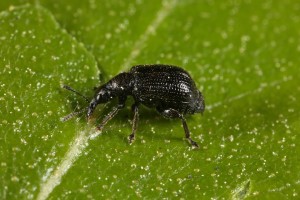
On 28th June I spent the day in Glen Affric, mainly photographing insects in the vicinity of Badger Falls and Dog Falls. There’s a good range of tree species there, including oak (Quercus petraea), hazel (Corylus avellana) and aspen (Populus tremula), as well as the more common trees such as Scots pine (Pinus sylvestris), downy birch (Betula pubescens) and rowan (Sorbus aucuparia), and in the summer it’s one of the best places in the glen to encounter a diverse range of insects that live on trees.
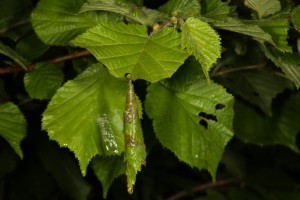
I stopped there this day to have a quick look at what I could see, and almost immediately I noticed something unusual on one of the young hazels growing beside the road. Several leaves had been cut across their centres, apart from beside the midrib of each leaf itself, and the lower, cut portion of each one had been rolled into a tight cylindrical shape that was hanging down from the intact portion of the leaf.
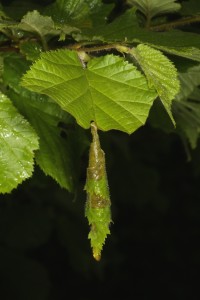
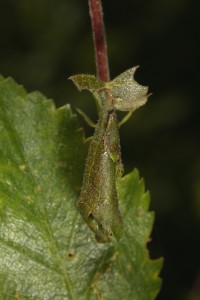
I’d never seen this before on a hazel, and I realised straight away that it must be the work of an insect of some sort, but I didn’t know which one. As I looked around, I saw more on some other hazels, and then I also spotted some of the leaf rolls on a downy birch tree that was growing nearby.
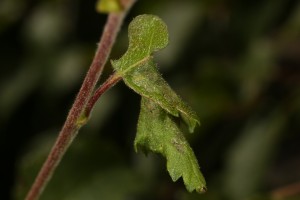
My curiosity was really piqued, so I began looking at the leaf rolls more carefully, to see if I could discover what was creating such beautiful shapes. I carefully unrolled one of the rolls, to find out if there was a larva or caterpillar inside, as a number of lepidopteran larvae develop inside rolled leaves, which protect them from predators. However, there was no sign of anything living inside this one.
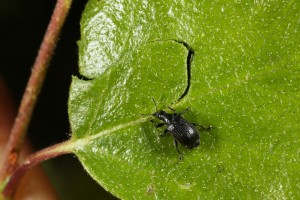
As I looked around at the leaves on the birch tree, my attention was grabbed by a small black shape on one of them. Moving closer, I saw that it was a black weevil, and at first glance it appeared to be feeding on the leaf. However, I realised almost immediately that it was actually cutting the leaf, and was doing so in an unusual, curved pattern. Here then was the agent responsible for the cut and rolled leaves I’d seen, and the sight of the weevil stimulated the memory of a conversation I’d had with a beetle expert about 11 years ago, when he’d done a survey for us in Glen Affric, and had referred to a weevil that rolled the leaves of birches.
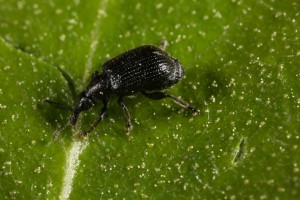
I’d not seen the weevil then during that survey, or indeed since that time, but I knew this was what I was seeing now, and I watched this one continuing to cut the leaf, while I took some more photographs of it. Back at home that evening a simple search on the Internet provided the name for the weevil – the birch leaf roller (Deporaus betulae). While it mainly cuts and rolls the leaves of birches, it also sometimes does so on other trees, including alder (Alnus glutinosa) and hazel, as I’d originally noticed this day.
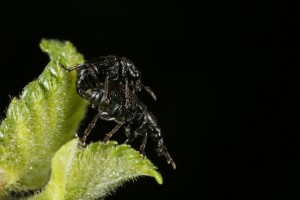
As to why the weevil goes to all this effort of cutting and rolling the leaves, the answer is simply that it does so to provide a safe place in which its larvae can develop. It is the female weevil that does all the leaf cutting and rolling, and she lays an egg inside each leaf roll, so that her young can grow there out of sight of predators. As I spent more time looking at this particular birch tree I noticed a couple of pairs of the weevils mating – one pair on the tips of some leaves, and another on one of the leaf rolls.
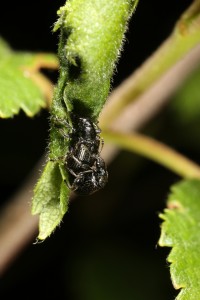
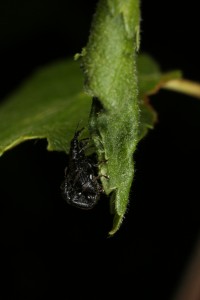
I was getting quite excited by this time as I realised was I seeing most of the lifecycle of this weevil acted out in front of my eyes. Having never seen it before at all, I was struck by how many were visible around me, and I suspect this is an especially good year for the species.
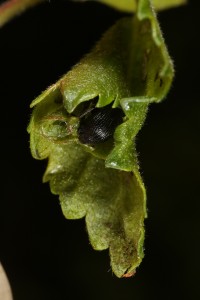
As I continued to look at the leaves on this birch tree, I found one leaf roll where a weevil was visible inside it, still at work. I couldn’t see what she (I assumed it was a female) was doing, but from what I’ve subsequently read about the species, I’ve learned that the female lays an egg inside each roll while she is making the roll tight. The tightening is apparently done by rolling the leaf margin inward from the edge, and is helped by the fact that the cut section of the leaf goes slightly limp, having been isolated from the supply of sap. The rolling continues until the finished result is a very neat and tight tapered shape which has been compared by some people to a cigar. It’s quite a remarkable achievement for such a small insect, particularly as the female weevil doesn’t have the benefit of the more distant observation point that we humans have, to appreciate the final product of her efforts.
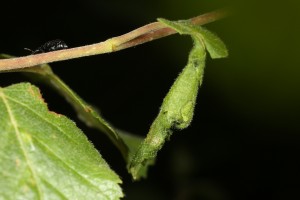
It seems to me that the industrious behaviour of this small weevil is one of the most impressive acts of creativity by an invertebrate. Various studies have been carried out to evaluate the technique that is used by the female in achieving the tightly-rolled leaf shapes for her eggs. In particular, the S-shaped cut that the female makes has been analysed in scientific studies and has been shown mathematically to be the most effective pattern in producing the optimal opportunity for the weevil larva to develop successfully inside the leaf roll.
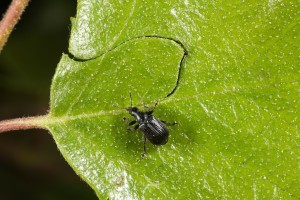
I wonder how the weevil achieves this? How does the female know to make a cut in this shape? Unlike with some mammals and birds, there is no parent on hand to pass learned behaviour on from one generation to the next, but nevertheless successive generations of weevils all prove to be adept in the same technique. Perhaps this is an example of what the biologist Rupert Sheldrake has described as habit-formation, or morphic resonance, in nature? In that theory he hypothesises that ‘self-organising systems inherit a memory from previous similar systems’. In this case perhaps the accumulated behaviour of previous generations of weevils somehow influences the actions of each new generation of weevils? It’s an interesting subject to speculate on, and, whatever the explanation, my experience this day with the birch leaf roller has only served to reinforce my sense of wonder at the complexity, diversity and beauty of the natural world all around us.
Just found this account after seeing the dark “trumpets” on a hazel bush (Corylus avellana) in a shady part of my garden near Ellon. Although it’s commonly called the birch leaf roller, it seems it is happy to do the same on hazel. Will have to keep a close eye on it to see if the beasts are still around, and also check the birches in the wood behind the house.
Thank you for this – how amazing! When we take time to look at nature, we can find all manner of amazing things, and to have them explained so succinctly simply adds to the wonder!
Andrew Pearce
Hi Andrew,
Yes, every time I find out something like this, it not only increases my sense of wonder about nature, but it also gives me pause to think how many more remarkable species and ecological relationships there might be out there, waiting to be discovered …
With best wishes,
Alan
What a wonderful story about an amazing little weevil. Thank you for passing it on to us here: the story of the forest in the palm of your hand.
Thanks for the feedback Ashley.
With best wishes,
Alan
This is a truly memorable story Alan, and one that not many folk will know about. Thank you for having the patience and focus to see and record. What an amazing weevil.
Thanks for all your great blogs,
Best wishes,
Vi
Hi Vi,
Thanks for the feedback about this and my other blogs. A large part of my inspiration and intention in writing these blogs is to share the wonders of nature and be a source of information about species, ecological relationships and behaviours that people may not know about, so it’s great to hear that it’s fulfilled this purpose for you.
With best wishes,
Alan